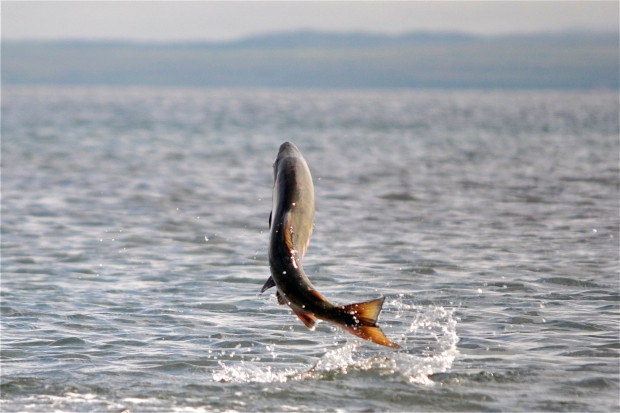We have much more to do and your continued support is needed now more than ever.
A New Path Forward for Salmon in the Columbia River Basin
The wild salmon and steelhead of the Columbia and Snake Rivers are truly one-of-a-kind. Many of these fish travel farther inland and higher in elevation than any salmon in the world, returning to some of the best-protected salmon habitat on the planet in central Idaho and northeastern Oregon.

Please add your support today with a message to decision-makers. Tell the Administration to Act Now to Save Columbia-Snake River Salmon!
With thirteen salmon and steelhead populations—and thousands of salmon-related jobs—at risk, twenty years of litigation over failed federal salmon plans, and more than $10 billion spent, the governor is proposing a different path forward. He is advocating a stakeholder-driven process to develop a plan that restores salmon and steelhead, creates jobs, invests in regional communities, and reduces the persistent uncertainty facing many businesses in Oregon and the Pacific Northwest.
A Stakeholder-Driven Process Might be Salmon’s Best Hope
Governor Kitzhaber thinks that the establishment of an inclusive stakeholder process may be the best way to craft a comprehensive, long-term salmon plan that works for both salmon and people. And he is asking other elected leaders in the Northwest and in Washington, D.C., to join him in making it a reality.
The governor published an op-ed on Sept 22nd in which he said, “By gathering the parties around a table, and working in good faith to reach common ground on a fisheries plan that is supported by sound science, we can come to the 2014 [court-ordered] deadline with a historic agreement that ends the 20-year chapter of salmon wars in the Columbia basin, an agreement that protects fish while maintaining our supply of clean and affordable energy.
While Governor Kitzhaber’s recent push is highly visible, he is not alone in seeking a new path forward. Tens of thousands of citizens, more than a thousand businesses, and scores of state and federal lawmakers have expressed similar support for a new approach that brings together the affected interests in the region to work together on an effective, science-based plan that restores Columbia Basin salmon and invests in Northwest communities and the economy.
Learn more about this “solutions table” for Columbia-Snake salmon.
Restoration Plans Mired in the Political Muck
For many years, efforts to restore salmon to this important watershed have proven both elusive and contentious. National Wildlife Federation initiated litigation in the early 1990s, following the listing of Snake River sockeye salmon under the Endangered Species Act (ESA). Since then, twelve additional stocks of salmon and steelhead in the Columbia Basin have been listed as threatened or endangered, and four of five federal plans developed by the federal government have been rejected as inadequate by the courts, most recently in 2011.
Commercial, sport, and tribal fishing communities and outdoor retail companies have been hit particularly hard by constrained fisheries and limited recreational opportunities and the loss of jobs and income caused by salmon population declines. Recovering salmon and steelhead to healthy, harvestable populations will restore thousands of jobs in the region’s salmon economy that have been lost in the last several decades. The development of an effective, science-based plan that has the support of the region’s leaders and stakeholders will increase certainty and help Northwest businesses and communities plan successfully for the future.
The question of whether to remove the lower Snake River dams in order to protect an irreplaceable Northwest icon has long been at the center of the debate on restoring salmon. Hundreds of fisheries biologists, including the Western Division of the American Fisheries Society (AFS), and dozens of studies have concluded that the removal of the lower Snake River dams in eastern Washington must be part of any effective Columbia Basin restoration plan. Today, all remaining stocks in the Snake River—sockeye, steelhead, fall Chinook, and spring-summer Chinook—are listed under the ESA.
The Impacts of Climate Change also Hamper Recovery
Steadily rising water temperatures in the Columbia and Snake Rivers as a result of a warming climate and dam-restricted flow are increasing the scrutiny of these dams. Water temperatures in the lower Snake and lower Columbia exceeded 70 degrees for much of this summer—frequently violating Clean Water Act standards and harming salmon and steelhead migrating to and from the ocean.
A free-flowing lower Snake River would significantly lower water temperatures in both the Snake and Columbia rivers, and reconnect Snake River fish to pristine habitat in the mountains of central Idaho, in places like the Salmon River and Redfish Lake. Many of these high elevation refuges—though largely inaccessible for salmon today—are being called the Noah’s Ark for salmon in a world of climate change. Many of these areas remain cold and snowy for much of the year, and thus provide salmon the cold, clear water that they depend upon.
Restoring wild salmon and steelhead in the Columbia and Snake Rivers remains an essential job and shared goal for the people of the Northwest and the nation. These fish represent critical threads in the Northwest’s economic, ecological, and cultural fabric: feeding ecosystems and people, sustaining jobs and ways of life.
With so much at stake, salmon and fishing advocates enthusiastically welcome Governor Kitzhaber’s call for a new approach, for a coming together of both allies and adversaries, to begin repairing what is broken in the Columbia Basin, in a manner that works for both salmon and people.
You can add your voice by taking action today: Tell the Administration to Act Now to Save Columbia-Snake River Salmon!





















